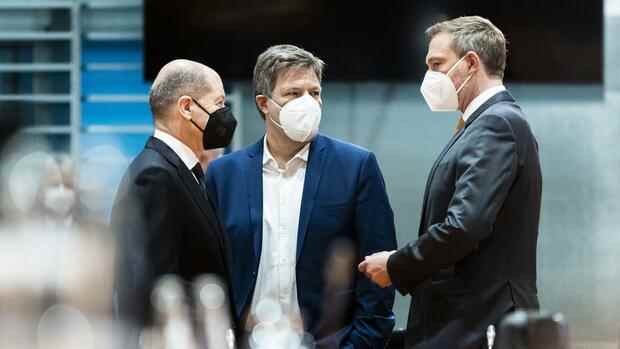The traffic light has agreed on a household.
(Photo: imago images/photothek)
Berlin In recent years, a coalition has rarely been able to finish the extensive set of figures so quickly. At 2.40 a.m., after less than 15 hours of negotiations, the traffic light reported completion: the 2022 budget is in place. The traditional clean-up session, with housekeepers fine-tuning the budget late into the night, was over.
Little has changed in the framework of the budget. At EUR 138.94 billion, net borrowing remains exactly as high as originally estimated. Expenditure rose again by 11.9 billion to 495.8 billion euros.
But a closer look at the financial tableau shows that there were bigger changes behind the big numbers. And they say something about the policies of the traffic light coalition, the current economic climate and long-term spending trends.
Enormous increase in personnel: What immediately catches the eye is the huge increase in jobs that the coalition partners are approving. The total number of jobs will increase by 5,269 compared to 2021. In the adjustment session alone, another 1,800 new jobs were added net. The federal government is now planning a total of 294,721 jobs in its entire area of responsibility. After all: After this increase in jobs, the traffic light then wants to save jobs across the board for the first time since 2015, around 100 are to be eliminated.
Top jobs of the day
Find the best jobs now and
be notified by email.
Ongoing Crisis Issues: The crises continue to leave deep scars on households. Health Minister Karl Lauterbach will receive another 14.1 billion euros to finance hospitals, procure corona vaccines and offer free corona tests, among other things. The federal government is also planning three billion euros more in corona aid for companies. Around one billion euros was also made available for the Ukraine at short notice.
More for retirement: Pension expenditure makes up an ever larger part of the budget because it continues to rise. This year alone, the federal government has to spend a billion euros more on pensions than originally estimated, even though there hasn’t been any major change in the law. This trend will continue in the coming years and will permanently burden the budget.
Debt financing is becoming significantly more expensive
Trend reversal in interest rates: Federal spending on new debt had recently fallen to a record low due to the persistent phase of low interest rates. But now the trend is reversing. Although interest rates rose only slightly, the federal government will have to spend EUR 5.3 billion more on interest payments this year than originally planned. The days of ultra-cheap borrowing seem to be over for the time being.
Higher tax revenues despite the war: The fact that the federal government can cope with all this additional expenditure is due to significantly higher tax revenues. Despite the slowing economy, income continues to be good. Inflation is flushing money into the state coffers, but so are the good employment situation and high corporate profits.
High lack of transparency in the budget: However, higher tax revenues alone are not enough to finance the higher expenditure while net borrowing remains constant. The traffic light experts are therefore shifting or reducing several provision items in the household. Even experienced household experts have trouble getting through it. Federal Finance Minister Christian Lindner has announced that he will dissolve the special pots and thus ensure more transparency in the budget.
More: War, inflation, the threat of a slump in growth – this is how you save your money now
